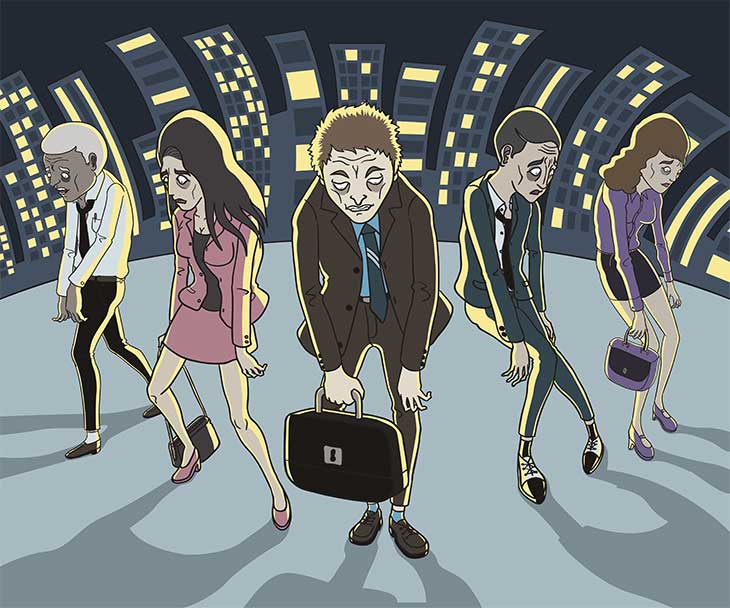How to Identify the Undead Employees At Your Company — And Bring Them Back to Life

The zombie apocalypse is here. It’s not an invasion of the undead, but rather the millions of Americans who show up at work everyday, their minds somewhere else entirely. There are zombies in your company, so disengaged it’s like they’re not really there at all.
Poor employee engagement is no small matter. Anyone who has ever had a job where they didn’t feel particularly committed knows how disengagement can foster low motivation, sloppy work, and general malaise.
Multiply these effects across many employees and your company has a serious problem. Low employee engagement affects a company’s productivity, the quality of its work, and ultimately its bottom line. In fact, disengaged employees cost companies an estimated $480-$600 billion a year in lost productivity. Yikes.
Think your company isn’t affected by low employee engagement? Think again. A Gallup study released this year found 70% of U.S. workers are not engaged at work. Disengagement is the rule, not the exception.
Keeping your employees from turning into disengaged zombies is as important a task as keeping your customers satisfied. Here’s what you need to know about low employee engagement, evaluating the engagement level of your employees, and keeping your employees happier and more productive.
The Dangers of Low Employee Engagement
If low employee engagement doesn’t fill you with an apocalyptic fear, it probably should. If your company reaches a critical mass of disengaged employees, it spells the end times for your business.
Low employee engagement leads to:
- Low employee retention. According to Gallup, 51% of U.S. workers are looking for new jobs. If your employees aren’t engaged, they’ll take their corporate knowledge with them as they leave, and your company will face the expensive and time-consuming process of hiring someone new.
- Destructive employees. Highly disengaged employees go far beyond merely taking up space. A 2015 study found that roughly 17% of employees are defined as actively disengaged, which means that they undermine the productivity of their coworkers, on top of not being engaged themselves.
- Lower revenues. One specialty mortgage banking company found disengaged employees generated 23% less revenue than their engaged colleagues. Even worse, actively disengaged account executives generated nearly 30% less revenue than engaged colleagues. Disengagement costs. Big time.
Put these together and it’s no wonder poor employee engagement costs U.S. companies billions of dollars in lost productivity annually.
10 Signs of Low Employee Engagement
How can you tell if your employees have “checked out” and become zombies? The signs are very clear.
Here’s a checklist to run through:
- Your customers aren’t happy with your employees.
- Employees get information from gossip more than official company communications.
- Employees consistently complain — to each other, to HR, to their managers.
- Employees don’t get along with each other.
- Employees are frequently late or absent.
- The quality of work is poor.
- Your company has a high turnover rate.
- Employees rarely propose new ideas or creative solutions to problems.
- Employees don’t participate in team meetings or socialize with coworkers.
- Employees are generally apathetic.
That last one is a big one: the biggest tell of low employee engagement might be apathy. If employees who once took pride in their work and actively contributed to a positive work environment now seem apathetic and withdrawn, it’s almost certain there is a morale problem.
How to Bring Your Employees Back to Life
To keep your employees from turning into zombies, treat them like living, breathing humans with human needs. That is what’s at the heart of making your employees engaged.
Employees are people, not machines. Expecting them to work without having opportunities to recharge, receiving appreciation for their efforts, or getting to focus on work they truly enjoy leads to low engagement, resentment, and burnout.
Don’t make the mistake of thinking that higher pay will lead to lower engagement. Compensation can help to improve engagement, but plays a more limited role in employee motivation than often believed. More important is giving people work they enjoy and providing them with a positive work environment where they are appreciated.
In fact, only 41% of employees say a significant increase in income is very important to them when considering a new job, which means a majority of employees are looking for something other than a bigger salary.
That’s not to say that money isn’t important. If you are paying people fairly and they are looking, it means there’s another reason. Rather, as Daniel Pink explains in Drive: The Surprising Truth About What Motivates Us, the important thing is to “pay people enough to take the issue of money off the table.” After employees are making a decent wage, salary is no longer the issue. Treating them well is.
Keep the zombie apocalypse at bay in your company by giving employees reasons to check back in. Give them opportunities to recharge. Make them feel valued and appreciated. Give them autonomy over how and when they get their work done. Allow them to do the work they most enjoy.
Treat them like people, and you’ll be able to bring the undead in your organization back to life.








